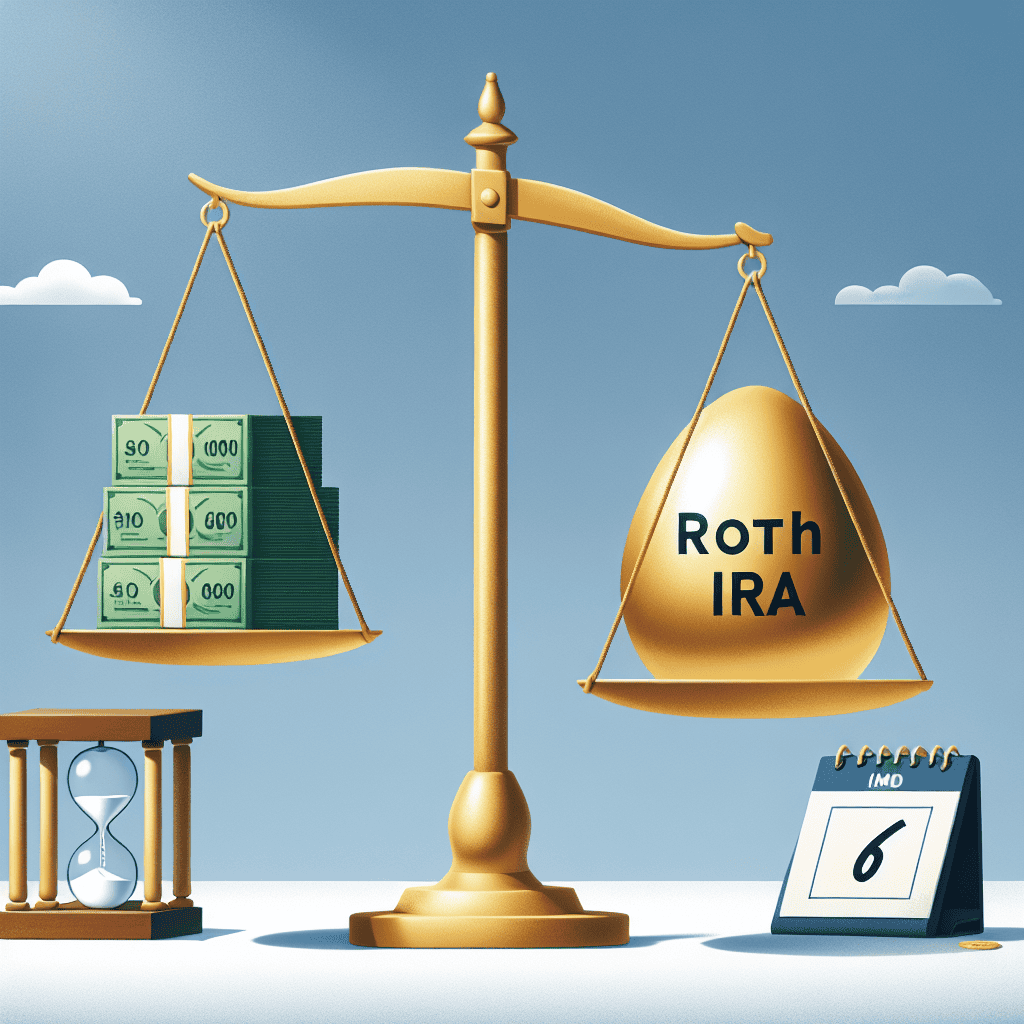“Maximize Your Retirement: Convert Smartly, Live Freely.”
Introduction
Converting $100,000 annually to a Roth IRA at age 60 can be a strategic financial decision for those looking to sidestep Required Minimum Distributions (RMDs) in retirement. As traditional IRAs and 401(k)s mandate RMDs starting at age 73, converting to a Roth IRA, which does not require RMDs during the account holder’s lifetime, can offer greater control over retirement income and tax planning. This approach can be particularly beneficial for individuals who anticipate being in a higher tax bracket in the future or who wish to leave a tax-free inheritance to their heirs. However, it’s crucial to consider the immediate tax implications of the conversion, as the converted amount will be subject to income tax in the year of conversion. Evaluating factors such as current and projected tax rates, overall retirement strategy, and estate planning goals is essential in determining whether this conversion aligns with one’s financial objectives.
Benefits Of Converting To A Roth IRA At Age 60
Converting $100,000 annually to a Roth IRA at the age of 60 can be a strategic financial decision, particularly for those looking to sidestep the implications of Required Minimum Distributions (RMDs) that come with traditional IRAs. As individuals approach retirement, the prospect of managing tax liabilities becomes increasingly significant. One of the primary benefits of converting to a Roth IRA is the potential for tax-free growth and withdrawals, which can be particularly advantageous for those who anticipate being in a higher tax bracket in the future. By paying taxes on the converted amount now, individuals can potentially reduce their taxable income in retirement, thereby minimizing the impact of RMDs.
Moreover, Roth IRAs do not require account holders to take RMDs during their lifetime, unlike traditional IRAs. This feature allows for greater flexibility in retirement planning, as individuals can choose when and how much to withdraw based on their needs rather than being compelled by regulatory requirements. This flexibility can be particularly beneficial for those who wish to leave a financial legacy for their heirs, as Roth IRAs can be passed on to beneficiaries without the burden of immediate taxation. Consequently, converting to a Roth IRA can serve as an effective estate planning tool, providing tax-efficient wealth transfer opportunities.
In addition to the tax advantages, converting to a Roth IRA at age 60 can also offer peace of mind in terms of financial security. With the unpredictability of future tax rates, having a portion of retirement savings in a Roth IRA can serve as a hedge against potential increases in taxes. This diversification of tax treatment across retirement accounts can provide a more balanced approach to managing retirement income, allowing individuals to draw from different sources depending on their financial situation and tax considerations at any given time.
Furthermore, the timing of the conversion plays a crucial role in maximizing the benefits. At age 60, individuals are typically nearing retirement, and their income may be lower than during their peak earning years. This potential reduction in income can result in a lower tax bracket, making it an opportune time to convert to a Roth IRA and pay taxes on the conversion at a potentially reduced rate. Additionally, spreading the conversion over several years, such as converting $100,000 annually, can help manage the tax impact by avoiding a significant spike in taxable income in any single year.
However, it is essential to consider the potential drawbacks and consult with a financial advisor to ensure that a Roth conversion aligns with one’s overall financial goals. The immediate tax liability incurred from the conversion can be substantial, and individuals must have sufficient funds outside of their retirement accounts to cover this cost without compromising their financial stability. Additionally, the five-year rule for tax-free withdrawals of earnings from a Roth IRA should be taken into account, as accessing these funds before the five-year period could result in penalties.
In conclusion, converting $100,000 annually to a Roth IRA at age 60 can offer numerous benefits, including tax-free growth, avoidance of RMDs, and enhanced estate planning opportunities. By carefully considering the timing and tax implications, individuals can strategically position themselves to enjoy a more flexible and tax-efficient retirement.
Understanding Required Minimum Distributions (RMDs)
When planning for retirement, understanding the intricacies of Required Minimum Distributions (RMDs) is crucial for effective financial management. RMDs are mandatory withdrawals that individuals must begin taking from their traditional retirement accounts, such as a Traditional IRA or 401(k), starting at age 72. These withdrawals are calculated based on the account balance and the account holder’s life expectancy, as determined by IRS tables. The primary purpose of RMDs is to ensure that individuals eventually pay taxes on their tax-deferred retirement savings. However, for those who wish to minimize their taxable income in retirement, converting funds to a Roth IRA can be an attractive strategy.
A Roth IRA offers a unique advantage in that it does not require RMDs during the account holder’s lifetime. This feature allows the account to grow tax-free for a longer period, providing more flexibility in managing retirement income. For individuals considering converting $100,000 annually to a Roth IRA at age 60, the decision involves weighing the benefits of sidestepping RMDs against the immediate tax implications of the conversion. Converting to a Roth IRA requires paying taxes on the converted amount in the year of the conversion, which can significantly impact one’s current tax situation.
To make an informed decision, it is essential to evaluate one’s current and projected tax brackets. If an individual anticipates being in a higher tax bracket in the future, converting to a Roth IRA now could be advantageous, as it locks in the current tax rate. Moreover, for those who have other sources of income to cover living expenses, converting to a Roth IRA can be a strategic move to reduce taxable income in later years. This approach can also be beneficial for estate planning purposes, as Roth IRAs can be passed on to heirs tax-free, providing a lasting financial legacy.
However, it is important to consider the potential drawbacks. The immediate tax liability from converting $100,000 annually can be substantial, potentially pushing the individual into a higher tax bracket for the year. Additionally, the decision to convert should take into account the individual’s overall financial situation, including other sources of retirement income, healthcare costs, and lifestyle needs. Consulting with a financial advisor or tax professional can provide valuable insights tailored to one’s specific circumstances.
Furthermore, the timing of the conversion plays a critical role. Converting earlier in retirement allows more time for the Roth IRA to grow tax-free, maximizing the benefits of the conversion. On the other hand, waiting until closer to the RMD age may limit the potential growth of the Roth IRA, reducing the overall advantage of the conversion. Therefore, a well-thought-out plan that considers both short-term and long-term financial goals is essential.
In conclusion, converting $100,000 annually to a Roth IRA at age 60 to sidestep RMDs can be a prudent strategy for those seeking to optimize their retirement income and minimize future tax liabilities. However, it requires careful consideration of current and future tax implications, as well as a comprehensive understanding of one’s financial landscape. By thoroughly evaluating these factors and seeking professional guidance, individuals can make informed decisions that align with their retirement objectives and financial well-being.
Tax Implications Of Roth IRA Conversions
Converting $100,000 annually to a Roth IRA at the age of 60 can be a strategic financial decision, particularly for those looking to sidestep Required Minimum Distributions (RMDs) in the future. However, it is crucial to understand the tax implications associated with such a conversion to make an informed decision. A Roth IRA conversion involves transferring funds from a traditional IRA or other retirement accounts into a Roth IRA. While this move can offer significant long-term benefits, it also comes with immediate tax consequences that must be carefully considered.
When you convert funds to a Roth IRA, the amount converted is treated as taxable income for the year in which the conversion occurs. This means that converting $100,000 annually could potentially push you into a higher tax bracket, depending on your other sources of income. Therefore, it is essential to evaluate your current tax situation and consider the impact of the conversion on your overall tax liability. Consulting with a tax advisor can provide valuable insights into how the conversion might affect your tax bracket and help you strategize to minimize the tax burden.
Moreover, the decision to convert should also take into account your future tax expectations. If you anticipate being in a higher tax bracket during retirement, converting to a Roth IRA now could be advantageous. This is because Roth IRAs offer tax-free withdrawals in retirement, provided certain conditions are met. By paying taxes on the converted amount now, you could potentially save on taxes in the future when you begin withdrawing funds. Additionally, Roth IRAs are not subject to RMDs, which means you can allow your investments to grow tax-free for a longer period, providing more flexibility in managing your retirement income.
Another factor to consider is the source of funds for paying the taxes on the conversion. Ideally, you should use funds from outside the IRA to cover the tax liability, as using IRA funds could diminish the benefits of the conversion. If you have sufficient non-retirement assets to pay the taxes, this could make the conversion more appealing. However, if paying the taxes would require tapping into your retirement savings, it might be worth reconsidering the conversion amount or timing.
Furthermore, it is important to consider the impact of the conversion on other aspects of your financial situation, such as eligibility for certain tax credits or deductions. A significant increase in taxable income could affect your ability to qualify for these benefits, potentially offsetting some of the advantages of the conversion. Therefore, a comprehensive review of your financial picture is necessary to ensure that the conversion aligns with your overall financial goals.
In conclusion, converting $100,000 annually to a Roth IRA at age 60 can be a beneficial strategy for avoiding RMDs and potentially reducing future tax liabilities. However, it is essential to carefully assess the immediate tax implications and consider how the conversion fits into your broader financial plan. By evaluating your current and future tax situation, understanding the source of funds for paying taxes, and considering the impact on other financial aspects, you can make a well-informed decision that supports your long-term retirement objectives. Consulting with a financial advisor or tax professional can provide additional guidance tailored to your specific circumstances, ensuring that your strategy is both effective and efficient.
Long-Term Financial Planning With Roth IRAs

When considering long-term financial planning, particularly as one approaches retirement, the decision to convert traditional IRA funds to a Roth IRA can be pivotal. For individuals at the age of 60, the prospect of converting $100,000 annually to a Roth IRA to sidestep Required Minimum Distributions (RMDs) is an option worth exploring. This strategy, while potentially beneficial, requires careful consideration of several factors to ensure it aligns with one’s overall financial goals.
Firstly, understanding the fundamental differences between traditional IRAs and Roth IRAs is crucial. Traditional IRAs allow for tax-deferred growth, meaning contributions are often tax-deductible, but withdrawals during retirement are taxed as ordinary income. Conversely, Roth IRAs are funded with after-tax dollars, allowing for tax-free withdrawals in retirement, provided certain conditions are met. This distinction is significant when considering the impact of RMDs, which are mandatory withdrawals from traditional IRAs starting at age 72, potentially increasing taxable income during retirement.
Converting to a Roth IRA can be an effective strategy to mitigate the impact of RMDs. By converting $100,000 annually, individuals can gradually reduce the balance in their traditional IRA, thereby decreasing future RMDs and the associated tax burden. This approach can be particularly advantageous for those who anticipate being in a higher tax bracket during retirement or who wish to leave a tax-free inheritance to their heirs. However, it is essential to recognize that Roth conversions are taxable events. The amount converted is added to one’s taxable income for the year, which could push the individual into a higher tax bracket, thereby increasing the immediate tax liability.
To navigate this complexity, it is advisable to conduct a thorough analysis of one’s current and projected tax situation. This includes evaluating current income levels, potential changes in tax legislation, and the anticipated growth of retirement assets. Additionally, considering the time horizon until retirement is crucial. At age 60, individuals have a relatively short window before RMDs begin, making it imperative to assess whether the tax benefits of conversion outweigh the immediate costs.
Moreover, it is important to consider the impact on other financial goals and obligations. For instance, if converting $100,000 annually would necessitate liquidating other investments or depleting cash reserves, it may not be the most prudent course of action. Balancing the desire to minimize RMDs with the need to maintain financial flexibility is key.
Furthermore, consulting with a financial advisor or tax professional can provide valuable insights tailored to one’s unique circumstances. These experts can help model different scenarios, taking into account factors such as life expectancy, expected retirement expenses, and potential changes in tax policy. They can also assist in developing a comprehensive retirement strategy that incorporates Roth conversions as part of a broader financial plan.
In conclusion, converting $100,000 annually to a Roth IRA at age 60 to sidestep RMDs can be a beneficial strategy for some individuals. However, it requires careful consideration of tax implications, financial goals, and overall retirement planning. By thoroughly evaluating these factors and seeking professional guidance, individuals can make informed decisions that align with their long-term financial objectives.
Comparing Traditional IRA And Roth IRA Strategies
When considering retirement planning, the decision to convert a traditional IRA to a Roth IRA is a significant one, particularly for individuals approaching retirement age. At 60, the prospect of converting $100,000 annually to a Roth IRA to sidestep required minimum distributions (RMDs) is an attractive strategy for many. To make an informed decision, it is essential to compare the benefits and drawbacks of traditional IRA and Roth IRA strategies.
Traditional IRAs offer the advantage of tax-deferred growth, allowing contributions to be deducted from taxable income in the year they are made. This can be particularly beneficial for individuals in higher tax brackets during their working years, as it reduces their immediate tax liability. However, the tax deferral comes with a caveat: RMDs. Once an individual reaches the age of 73, they are required to begin withdrawing a minimum amount from their traditional IRA each year, which is then subject to income tax. This can be a disadvantage for those who wish to keep their retirement savings intact for as long as possible or who anticipate being in a higher tax bracket during retirement.
In contrast, Roth IRAs offer tax-free growth and tax-free withdrawals in retirement, provided certain conditions are met. Contributions to a Roth IRA are made with after-tax dollars, meaning there is no immediate tax benefit. However, the absence of RMDs for Roth IRAs can be a compelling reason to consider conversion, especially for those who wish to maintain control over their retirement funds and potentially leave a tax-free inheritance to their heirs.
Converting $100,000 annually from a traditional IRA to a Roth IRA at age 60 can be a strategic move to mitigate the impact of RMDs. By doing so, individuals can spread the tax liability over several years, potentially keeping themselves in a lower tax bracket and avoiding a large tax hit in any single year. Additionally, this strategy allows for the growth of the converted funds to continue tax-free, which can be advantageous if the individual expects to be in a higher tax bracket in the future or if they anticipate significant investment growth.
However, it is crucial to consider the potential downsides of this strategy. The primary concern is the immediate tax liability incurred by converting funds from a traditional IRA to a Roth IRA. Depending on the individual’s current tax bracket, this could result in a substantial tax bill. Therefore, it is essential to evaluate whether the long-term benefits of tax-free growth and the elimination of RMDs outweigh the short-term tax costs.
Moreover, individuals should consider their overall financial situation, including other sources of retirement income, expected future tax rates, and estate planning goals. Consulting with a financial advisor or tax professional can provide valuable insights tailored to one’s specific circumstances, ensuring that the decision aligns with their broader financial objectives.
In conclusion, converting $100,000 annually to a Roth IRA at age 60 to sidestep RMDs can be a prudent strategy for some individuals. By carefully weighing the benefits of tax-free growth and the elimination of RMDs against the immediate tax implications, individuals can make a well-informed decision that supports their long-term financial goals. As with any financial strategy, personalized advice from a professional can be invaluable in navigating the complexities of retirement planning.
Timing Your Roth IRA Conversion For Maximum Benefit
When considering the conversion of $100,000 annually to a Roth IRA at the age of 60, it is crucial to evaluate the timing and potential benefits of such a financial decision. The primary motivation for many individuals contemplating this move is the desire to sidestep Required Minimum Distributions (RMDs) that come into play with traditional IRAs. By converting to a Roth IRA, one can potentially enjoy tax-free growth and withdrawals, provided certain conditions are met. However, the decision to convert should not be taken lightly, as it involves a complex interplay of tax implications, future financial needs, and market conditions.
To begin with, understanding the tax implications is essential. Converting a traditional IRA to a Roth IRA involves paying taxes on the converted amount, as the funds are moved from a tax-deferred account to a tax-free account. This means that the $100,000 conversion will be added to your taxable income for the year, potentially pushing you into a higher tax bracket. Therefore, it is important to assess your current and projected future tax rates. If you anticipate being in a higher tax bracket in retirement, converting now might be advantageous. Conversely, if you expect your tax rate to decrease, it may be prudent to delay the conversion.
Moreover, the timing of the conversion can significantly impact the overall benefit. Converting at age 60 allows for a longer time horizon for the Roth IRA to grow tax-free, which can be particularly beneficial if you do not need to access the funds immediately. This extended growth period can enhance the compounding effect, potentially leading to a larger nest egg in retirement. Additionally, by converting before reaching the age of 72, you can avoid RMDs altogether, thereby preserving your retirement savings and providing greater flexibility in managing your withdrawals.
Another factor to consider is your current financial situation and liquidity needs. Converting $100,000 annually requires having sufficient funds to cover the tax liability without dipping into your retirement savings. It is advisable to have a clear understanding of your cash flow and ensure that you have adequate resources to pay the taxes due on the conversion. This might involve using non-retirement assets or other income sources to cover the tax bill, thereby preserving the integrity of your retirement accounts.
Furthermore, market conditions can also play a role in the timing of your conversion. Converting during a market downturn might be beneficial, as the value of your IRA may be lower, resulting in a smaller tax liability. Conversely, converting during a market upswing could lead to a higher tax bill, as the value of the assets being converted would be greater. Therefore, keeping an eye on market trends and consulting with a financial advisor can help in making an informed decision.
In conclusion, converting $100,000 annually to a Roth IRA at age 60 can offer significant benefits, particularly in terms of avoiding RMDs and allowing for tax-free growth. However, it is essential to carefully consider the tax implications, timing, and your overall financial situation before proceeding. By evaluating these factors and seeking professional guidance, you can make a well-informed decision that aligns with your long-term retirement goals.
Potential Pitfalls Of Converting To A Roth IRA
Converting $100,000 annually to a Roth IRA at the age of 60 can be an appealing strategy for those looking to sidestep required minimum distributions (RMDs) in retirement. However, while the benefits of such a conversion are often highlighted, it is crucial to consider the potential pitfalls that may accompany this financial decision. Understanding these challenges can help individuals make more informed choices about their retirement planning.
One of the primary concerns when converting a traditional IRA to a Roth IRA is the immediate tax liability incurred. Since contributions to a traditional IRA are typically made with pre-tax dollars, converting these funds to a Roth IRA requires paying taxes on the converted amount. For someone converting $100,000 annually, this could result in a significant tax bill, potentially pushing the individual into a higher tax bracket. Consequently, it is essential to evaluate whether the long-term benefits of tax-free withdrawals from a Roth IRA outweigh the short-term tax implications.
Moreover, the timing of the conversion plays a critical role in determining its financial impact. Converting during a year when one’s income is lower can mitigate the tax burden, but this is not always feasible. Additionally, individuals must consider the potential for future changes in tax legislation. While current tax rates may make a conversion seem advantageous, future increases in tax rates could alter the equation. Therefore, it is important to remain flexible and adaptable to changing tax environments.
Another potential pitfall is the impact on other financial aspects, such as Medicare premiums. The income generated from a Roth conversion can increase an individual’s modified adjusted gross income (MAGI), which may lead to higher Medicare Part B and Part D premiums. This increase, known as the Income-Related Monthly Adjustment Amount (IRMAA), can add unexpected costs to one’s retirement budget. As such, it is vital to consider how a Roth conversion might affect overall healthcare expenses.
Furthermore, individuals should be mindful of the five-year rule associated with Roth IRAs. This rule stipulates that for earnings to be withdrawn tax-free, the Roth IRA must be held for at least five years. For those converting at age 60, this may not pose a significant issue, but it is an important consideration for those who may need to access their funds sooner. Failing to adhere to this rule could result in unexpected taxes and penalties, undermining the benefits of the conversion.
Additionally, the decision to convert should be weighed against other retirement goals and strategies. For instance, individuals may have other investment opportunities that offer better returns or align more closely with their financial objectives. It is crucial to assess whether a Roth conversion is the most effective use of available resources, considering the broader context of one’s retirement plan.
In conclusion, while converting $100,000 annually to a Roth IRA at age 60 can offer significant advantages, such as avoiding RMDs and benefiting from tax-free withdrawals, it is not without its challenges. The immediate tax implications, potential impact on Medicare premiums, and adherence to the five-year rule are all critical factors that must be carefully evaluated. By considering these potential pitfalls and integrating them into a comprehensive retirement strategy, individuals can make more informed decisions that align with their long-term financial goals.
Q&A
1. **What are RMDs?**
Required Minimum Distributions (RMDs) are mandatory withdrawals that must be taken from traditional IRAs and other retirement accounts starting at age 73 (as of 2023).
2. **What is a Roth IRA?**
A Roth IRA is a retirement account where contributions are made with after-tax dollars, and qualified withdrawals are tax-free.
3. **Why consider converting to a Roth IRA?**
Converting to a Roth IRA can help avoid RMDs, as Roth IRAs do not have RMDs during the account holder’s lifetime.
4. **What are the tax implications of converting $100,000 annually?**
Converting $100,000 annually from a traditional IRA to a Roth IRA will be considered taxable income, potentially increasing your tax bracket.
5. **How does age 60 impact the decision?**
At age 60, you have time before RMDs begin at age 73, allowing for strategic conversions over several years to manage tax impacts.
6. **What are the benefits of converting to a Roth IRA?**
Benefits include tax-free growth, no RMDs, and potentially lower taxes in retirement if tax rates increase.
7. **What are the potential downsides?**
The main downside is the immediate tax liability from the conversion, which could be significant depending on your current tax bracket.
Conclusion
Converting $100,000 annually to a Roth IRA at age 60 to avoid Required Minimum Distributions (RMDs) can be a strategic move, but it depends on several factors. If you expect to be in a higher tax bracket in retirement, converting now could be beneficial as you pay taxes at your current rate. Additionally, Roth IRAs offer tax-free growth and withdrawals, and they are not subject to RMDs, which can provide more flexibility in managing your retirement income. However, consider the immediate tax implications of the conversion, as it will increase your taxable income for the year. It’s also important to ensure you have the funds to pay the taxes without dipping into the converted amount. Consulting with a financial advisor is recommended to tailor this strategy to your specific financial situation and goals.




